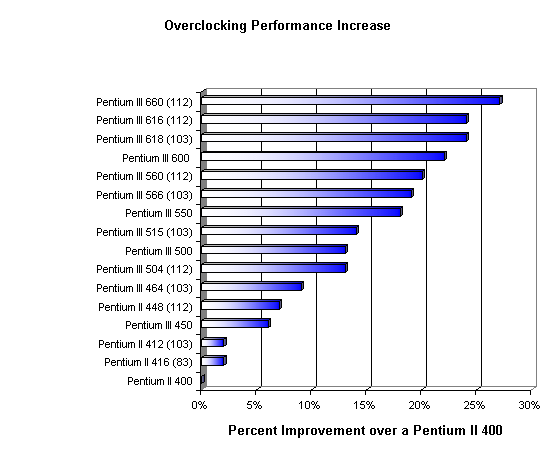The Future of the Pentium III
"The physical limit of the Pentium III’s current manufacturing process happens to be around the 700MHz mark, meaning that it wouldn’t be too far fetched to "hypothesize" the 0.18 micron Coppermine processors that are due out later this year would feature clock speeds of around 700MHz+. It also wouldn’t be surprising to see the "mysterious" arrival of a 600MHz Pentium III (not Coppermine, current technology – 0.25 micron) if AMD does indeed ship their upcoming K7 at 550MHz as planned. Intel won’t stand idle as AMD takes the lead in the clock frequency race, and the potential of the overclocked 550 is proof in itself that Intel could make the move to 600MHz and beyond if the need were to come around."
That statement was made in AnandTech’s Pentium III 550 review completed less than six months ago, low and behold, the "mysterious" arrival of a 600MHz Pentium III (0.25 micron) is upon us. With the Pentium III 550, it was confirmed that a 700MHz clock speed could in fact be attained on the current manufacturing process. Intel’s 0.18 micron Coppermine processor (the next generation Pentium III) is experiencing delay after delay and the release of AMD’s Athlon (K7) at speeds greater than 600MHz is very likely within the next two months. It wouldn’t be surprising if Intel extended the life of the current manufacturing process once again, the Pentium III 600 may see a 650MHz brother if the Pentium III 667 (133MHz FSB) doesn’t make its way out the door soon enough. It was almost guaranteed that we’d see a 600MHz Pentium III after the release of the 550MHz part, since AMD was already leaking information about 600MHz Athlon parts available for sale the day of the official release.
From experiences dealing with Intel directly, the company generally knows what the competition is preparing. Intel knew more about the Athlon than the general public and even some reviewers, a somewhat interesting fact but impressive nonetheless. Intel should have some idea of what AMD is preparing in terms of 650MHz parts, if not, let’s just put it this way, Intel isn’t the only company that has accelerated their roadmap. AMD is looking to go head to head with Intel, bar none and if that means releasing a 700MHz Athlon before year’s end, then it may come to that.
There is no doubt about it, Intel accelerated the release of the Pentium III 600 to within days of the physical release of the Athlon 600 processor for the sake of competition. What’s AMD’s response? A six, a five, and a zero. Although they may not know it, the ball is in Intel’s court now, don’t you just love competition?
Overclocking
As we have come to expect and take for granted (most tweakers feel cheated if their Intel CPUs won't overclock), Intel's high yield on their 0.25 micron parts has given us the ability to overclock to a healthy degree in order to gain a helpful bit of performance free of charge. It was once thought that 550MHz would be the theoretical limit of Intel's 0.25 micron manufacturing process, however the delays in Intel's Camino (820) chipset and the move to a 0.18 micron fabrication process as well as increasing heat from AMD to push the 600MHz limit has forced Intel to release the 600MHz part based on their 0.25 micron core. AnandTech's Pentium III 600 sample was able to make it up to 660MHz by using the 112MHz FSB frequency, anything above 660MHz was either too unstable (even with an increase in the core voltage) for normal operation or would not boot at all.
For the fastest desktop Intel processor available today, the overclocking outlook of the Pentium III 600 is not that great. With a bit of added cooling it may be able to hit the 700MHz mark as we were able to get the system to cold boot at 700MHz however the test bed would hang after a very short period of time, often times not making it past the Power On Self Test. As Intel's yields improve on the Pentium III 600, reaching the 700MHz mark will become more dependent on the quality of the L2 cache and the ability of it to run at 1/2 of 700MHz, or 350MHz.
For those of you that are interested in the performance gains provided by overclocking, take a look at the following chart that illustrates the gain in Business Application Performance:

Although the increase in gaming performance will yield different performance results, using the gaming tests we conducted you should be able to generally predict the performance increase you'll receive from overclocking.
The Test
AnandTech's Slot-1 Test Bed was
configured as follows:
ABIT BX6 Revision 2.0 w/ Intel
Pentium III 600 Engineering Sample
128MB Mushkin SDRAM
Western Digital Caviar AC35100 - UltraATA
NVIDIA TNT2 Ultra clocked at
150/183MHz (32MB SDRAM) using Detonator 2.08 drivers
Ziff Davis Winstone 99 was run
under Windows 98 SE and Windows NT Workstation 4.0 at 1024 x 768 x 16-bit color
idSoftware's Quake 3 Arena Test 2 v1.07 was run at all four video configuration settings
using q3testdemo1.dm3










0 Comments
View All Comments